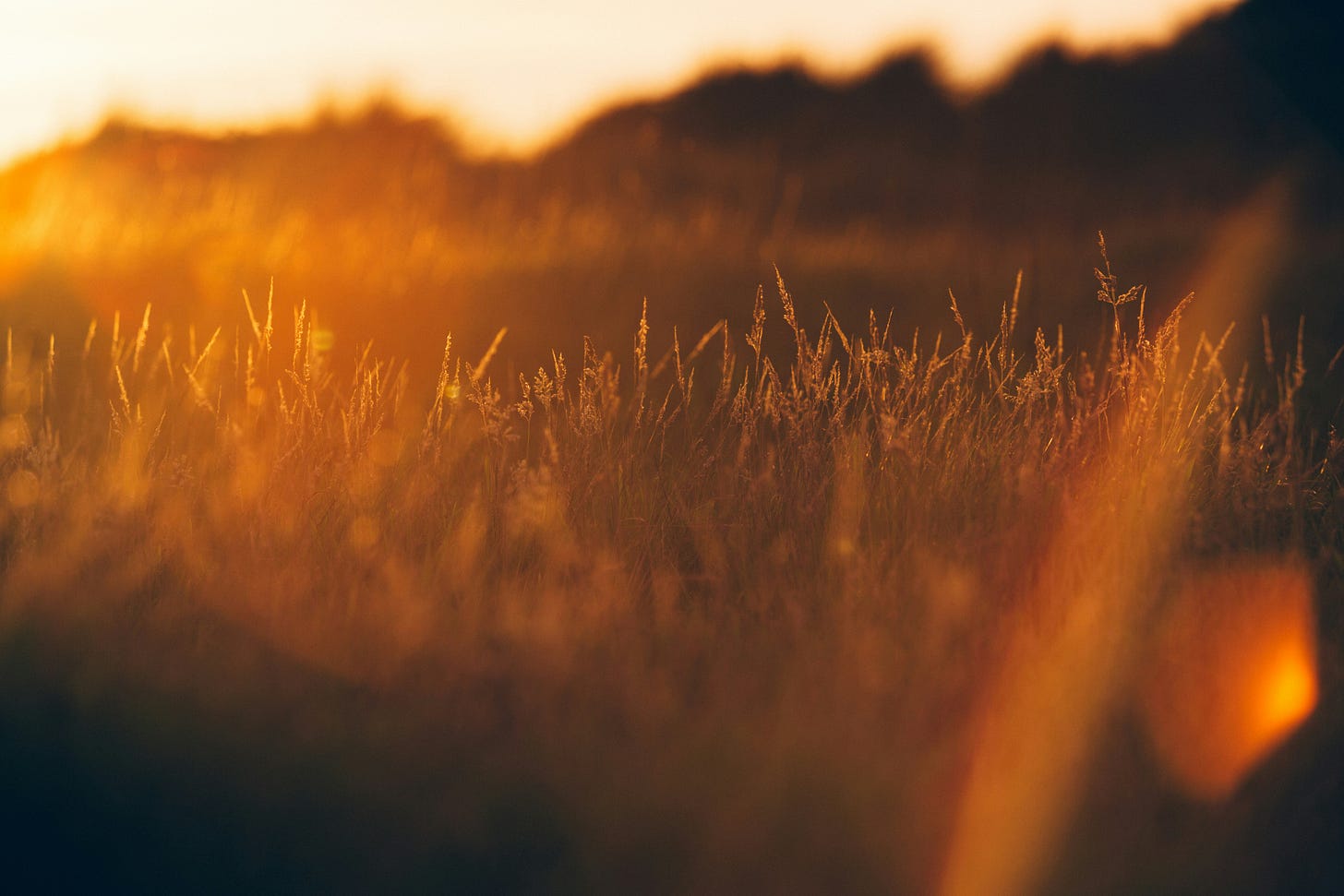The Scribbled Layers of Community
Thoughts on Communion, Easter, and Holy Participation
In the low light of the candles, my brother and I sat with our faces down, trying not to snicker. We knew the moment was serious, but we were only children—sitting still at the communion table was not in our job description. Though the time seemed trivial then, something stirs in me now when I consider what was cultivated around that table.
“You shall never wash my feet, Lord.” Peter was impetuous.
“If I do not wash your feet, you will have no part with me.” Jesus was gracious—but firm.
“Then not only my feet but my head and my hands as well.” Peter was all or nothing.
“You need only to have your feet washed. The rest of your body is clean.”
Communion permeated my childhood even though it was an irregular occurrence. It was the honeysuckle of my days, sweetening all other aspects of life. It was the symbol of our constant state of togetherness: congregants serving others in the church … the church serving the community … God glorified. It seemed natural. It seemed to be what Christians did.
But time manages to disguise the brilliance of our youth in adult complexities. What was gleamingly simple then is now a robust equation we must all try to decipher.
Somewhere along the way, we forgot how to be friends. Somewhere along the way, the natural order of my communal childhood was disturbed—now, we must be “intentional” if we want to connect with people.
Slow Churned Laughing Faces
We would wash one another’s feet as Jesus did in the upper room. I would always wash my brother’s or my dad’s feet. It gave me a safe feeling, like playing catch. Then, we would always come around a common table.
“The disciples ate together—sharing in the love feast.” My dad was a preacher and poet. “And after they took the bread and the cup, they sang a song and went off into the night.”
I remember it that way, though it is probably written differently.
So we would sing a song; most often, it was “Blest Be The Tie That Binds.” It is a song of our unity centered on the Christ—a song we sang through the candlelight, lifting to our God our desire to “share each other’s woes, our mutual burdens bear.”1
It is like a record of things from the beginning of time till now, and throughout the verses, a singular thought permeates everything, drawing the reader “further up and further in”2 until, at long last, an understanding descends in the form of a chalice of blood and a piece of breaded flesh. It is the Christ, drawing us to Himself.
I long viewed life, God, and Christianity like the linear stanzas of a hymn—the payoff always comes in the chorus—this plus this equals that, line by line, then the chorus. But I’ve found that the idea of community is far from linear and more like figure eights scribbled on top of one another. There never really is a payoff; there is only the continual overlapping of lives weaving in and out of one another.
And that is how I remember it. Families I would see at church bring their kids to the pool during the summer to play with other families. After the morning services, I watched those families bring food to church for potluck lunches. Those were the best days.
The kids were allowed to run and play all over the church grounds while the adults ate lunch, talked, and laughed. Sunday afternoon usually carried over into the evenings—people would end up at my Dad’s house for ice cream and conversation.
How often did I lie in bed and listen to the adults laugh from their bellies into the late hours? That’s what Christians did.
I remember yawning my way into the cold metal chairs my dad would set up on the hill in front of the church on Easter Sunday. Sunrise service was just what we did. Pink shirt, white pants, white shoes, Izod jacket—my gaze firmly planted in the searing red Florida sky—waking with it. My mind tumbled over the low-lying fog and across the valley toward the distant hill.
“Look there. On the ridge … see those three telephone poles?” One of the elders spoke.
“There are three poles together, and the middle one is just a bit higher—it looks like Calvary.”
Maybe it was Calvary. Maybe across the valley fog on that ridge, amid three telephone poles, the cross of Christ somehow appeared in all its agonizing glory.
I thought, “Yes, God would do that for us on this day of days.” Of course, Jesus brandished the sky with reds and oranges and positioned the telephone poles to make it look like the place where he died.
It was Easter Sunday, and the entire world was waiting to hear from God. But few were seated with our little brethren on the hill that morning.
And almost no one saw that cross in the middle. But I did. And it sits in my mind now with the image of the communion candles—warm and wonderful, mysterious and perfect.
Those times of togetherness surface in my memory waters often. When they do, I invariably think about how things have changed. Now, the simplistic joys of childhood seem lost. Humanity has expanded at the speed of technology; we move where we please, giving little thought to the needs of others.
Community seemed so simple back when … front porches were actually used, Atari occupied us only when it rained, and Wednesday night church was the highlight of the week (well, at least a close second to Monday Night Football).
But even though I can speak of my memories as a collection of sweet, flowery moments, the reality is that community is as difficult as it is beautiful. It was hard when my friend’s dad was killed on his motorcycle. It was difficult when the girl from the youth group got pregnant. But people gathered, loved, and supported; it was all wonderfully teary.
The Tangle Root
Sometimes, it is difficult to decipher, but the tangled mess of community strangles and splinters itself into a root system that will not relinquish the earth around it—you and I brought together in the dirt of intermingling life. We are bound together. It is not a beautiful arrangement—roots never are. However, the by-product of this mangled root system is glorious. It is like honeysuckle in the late spring air—intoxicating.
I can only imagine that the system the infant church employed was equally gnarled and knotted. What else could happen when “all the believers were together and had everything in common?”3 The more entwined our lives are, the bigger the mess becomes when a portion is disrupted.
How can we reclaim those community times—the laughing, crying, and giving of ourselves and growing? Buechner hints at the mystery behind this Holy Communion—“a symbol of his followers’ participating in this life, this giving,” in his life, his resurrection. The holy impetus for community is “the me in thee. Now you go for us both. Truly.”4
As we enter this holy weekend, my prayer is that as we consider the pain and suffering of Christ, that we remember his reason for emptying himself and coming into this world. It was to defeat the consequences of our sin—the separation of communion with our Father. And that we can learn to love one another as Christ loved us and gave himself as a ransom—that the world might come to him, and find rest.
He is Risen!
He is Risen, Indeed!
Happy Easter, my friend,
Tim.
I’m collaborating with my wife, Chris, and my dear friend, Daunte Pittman, to bring you an online version of our creative arts retreat, Foraged Beauty. Click the button below to learn more and take advantage of early registration prices.
“Blest Be the Tie that Binds,” Lyrics by John Fawcett, 1782.
C. S Lewis and Pauline Baynes, The Last Battle / The Chronicles of Narnia / # 7 (New York: Macmillan, 1970), see Chapter 15.
Acts 2:44
Beuchner quoting Earnest Hemmingway’s For Whom The Bell Tolls




Loved your ‘foraging beauty’ part in the retreat . Just authentically u with a lovely message. Stumbled on a book ‘ beauty and faith’ about the act that Jesus called beautiful - the woman and the alabaster jar. It’s you.
Love this. Thank you for sharing, and happy Easter! ✨